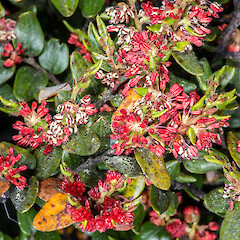Fuscospora cliffortioides
Common name
mountain beech
Synonyms
Fagus cliffortioides Hook.f., Nothofagus solandri var. cliffortioides (Hook.f.) Poole, Nothofagus cliffortioides (Hook. f.) Oerst.
Family
Nothofagaceae
Flora category
Vascular – Native
Endemic taxon
Yes
Endemic genus
No
Endemic family
No
Structural class
Trees & Shrubs - Dicotyledons
NVS code
The National Vegetation Survey (NVS) Databank is a physical archive and electronic databank containing records of over 94,000 vegetation survey plots - including data from over 19,000 permanent plots. NVS maintains a standard set of species code abbreviations that correspond to standard scientific plant names from the Ngä Tipu o Aotearoa - New Zealand Plants database.
NOTCLI
Chromosome number
2n = 26
Current conservation status
The conservation status of all known New Zealand vascular plant taxa at the rank of species and below were reassessed in 2017 using the New Zealand Threat Classification System (NZTCS) – more information about this can be found on the NZTCS website. This report includes a statistical summary and brief notes on changes since 2012 and replaces all previous NZTCS lists for vascular plants.
Please note, threat classifications are often suggested by authors when publications fall between NZTCS assessment periods – an interim threat classification status has not been assessed by the NZTCS panel.
- Conservation status of New Zealand indigenous vascular plants, 2017 . 2018. Peter J. de Lange, Jeremy R. Rolfe, John W. Barkla, Shannel P. Courtney, Paul D. Champion, Leon R. Perrie, Sarah M. Beadel, Kerry A. Ford, Ilse Breitwieser, Ines Schönberger, Rowan Hindmarsh-Walls, Peter B. Heenan and Kate Ladley. Department of Conservation. Source: NZTCS and licensed by DOC for reuse under the Creative Commons Attribution 4.0 International licence.
2017 | Not Threatened
Previous conservation statuses
2012 | Not Threatened
2009 | Not Threatened
2004 | Not Threatened
Brief description
Very common forest canopy tree in drier upland areas bearing small leathery leaves arranged along the twig and that are pale underneath and with incurved margins. Leaves 10–15 mm long, appearing pointed. Flowers and fruits inconspicuous, but these and new leaf growth can change a trees colour.
Distribution
Endemic. New Zealand: North Island (common from the Central Volcanic Plateau and adjacent main axial ranges), South Island.
Habitat
Montane forest and subalpine forest and scrub. Often forming a dense, almost monospecific forest especially along the main North Island axial ranges and along the drier, eastern side of the South Island.
Wetland plant indicator status rating
Information derived from the revised national wetland plant list prepared to assist councils in delineating and monitoring wetlands (Clarkson et al., 2021 Manaaki Whenua – Landcare Research Contract Report LC3975 for Hawke’s Bay Regional Council). The national plant list categorises plants by the extent to which they are found in wetlands and not ‘drylands’. The indicator status ratings are OBL (obligate wetland), FACW (facultative wetland), FAC (facultative), FACU (facultative upland), and UPL (obligate upland). If you have suggestions for the Wetland Indicator Status Rating, please contact: [Enable JavaScript to view protected content]
FAC: Facultative
Commonly occurs as either a hydrophyte or non-hydrophyte (non-wetlands).
Similar taxa
Morphologically very similar to black beech (Fuscospora solandri) from which it differs by the ovate leaves with acute to subacute apices, obscure leaf venation and by the glabrous ovary of the flower. Appears to prefer drier conditions than black beech, and has a greater altitudinal range, though it is often sympatric with black beech.
Flowering
November–January
Flower colours
Red/Pink
Fruiting
February–April
Propagation technique
Easy from fresh seed, Cuttings are very difficult to strike. Young plants are very quick growing but do best in cool climates.
Where To Buy
Commonly cultivated in suitable climates. Frequently available from commercial nurseries.
Taxonomic notes
Although many botanists have tended to regard Fuscospora cliffortioides as a variety of black beech (F. solandri), or even disregard it altogether, recent DNA data combined with phylogenetic mapping of character states confirm the view of Molloy et al. (1999) that F. cliffortioides is a distinct species (see Heenan & Smissen 2013). Nevertheless field recognition is often hampered by the fact that both F. cliffortioides and F. solandri hybridise, and in some places the hybrids may form complex introgressive hybrid swarms. In these situations it is understandable that field botanists in particular have interpreted ‘hybrid swarms’ as evidence of a cline between both ‘species’ resulting in the interpretation of either the one species (F. solandri) or two varieties.
Keystone significance
Main host for yellow mistletoe (Alepis flavida) and red mistletoe (Peraxilla tetrapetala).
References and further reading
Heenan PB, Smissen RD. 2013. Revised circumscription of Nothofagus and recognition of the segregate genera Fuscospora, Lophozonia, and Trisyngyne (Nothofagaceae). Phytotaxa 146: 1–31. http://dx.doi.org/10.11646/phytotaxa.146.1.1.
Molloy BPJ, de Lange PJ, Clarkson BD. 1999. Coprosma pedicellata (Rubiaceae), a new species from New Zealand. New Zealand Journal of Botany 37(3): 383–397. https://doi.org/10.1080/0028825X.1999.9512643.
Skipworth JP. 1981. Mountain beech mortality in the West Ruapehu forests. Wellington Botanical Society Bulletin 41: 26–34.






